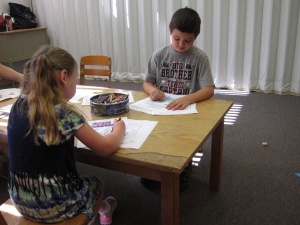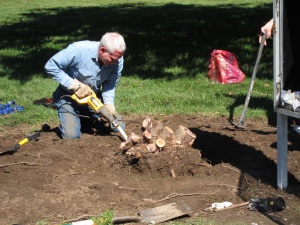September 22, 2012
p. 1387
31:1 “I am now one hundred and twenty years old, I can no longer be active.” God will lead them into battle – although this can also be read as if God is taking care of their enemies for them. The chronology of matching this up with 40 years in the desert is difficult – if not impossible. “There is no before and after in the Torah.” ML: How can we be sure that Moses existed? PG: We cannot with historical accuracy. There are no contemporaneous unbiased accounts to reference. That is true of Jesus, Buddha and Confucius as well. We know that life can turn into legend. The use of archetypical names does not mean that there weren’t individuals who held those names. This section was written down centuries after the events described. The author(s) are writing down “the Moses story” but they had no tools with which to conduct historical analysis. It is believed, based on non-biblical archeological evidence, that there was the formation of this people of Israelites in the period from about 1500 to 1000 BCE. There is similar evidence that David and Solomon created a unified kingdom. What are thought to be the tombs of Abraham do contain ancient bones but they have not been carbon dated. See Friedman on “Who Wrote The Bible” which is the best analysis of these questions as to the source of this text. Generally, the different stories have been woven together, blended, in a very smooth way. But consider the two versions of creation which is there “in your face” without any effort to reconcile the two versions. For two thousand years the reader did not attempt to see these textual conflicts in any other context than faith – it was written by God. It was not until about the time of Spinoza in the early 17th C. that other explanations were sought – such as the political resolution of different traditions from the north and south. CL: In looking at different cultures we see that there is very little novelization going on – the writers are recognizing existing oral traditions. PG: Consider the last line of “”The Man Who Shot Liberty Valance.” “When all you have left is the legend – believe the legend.” See: http://en.wikipedia.org/wiki/The_Man_Who_Shot_Liberty_Valance
31:7 The role of Joshua as intermediary between Moses and the people. He is one of the few sole survivors of the exodus from Egypt. The text is suggesting more than just an invasion – it is the fulfillment of an early promise. This is the second time in the Torah that we have a teaching written down by Moses and then given to another. The first time was upon the occasion of Moses descending from Mt. Sinai.
31:10 Every seventh year at the feast of booths you shall read this teaching aloud – hear and learn. Succoth is the harvest holiday but in the 7th year there is no harvest. Nevertheless, you come to temple to hear a marathon reading of the Torah. This proceeds over a period of days. People came to hear and discuss before there was a prayer service. RR: It has been suggested that the reading was only of Deuteronomy. PG: I would dispute that. By the time this is promulgated it is the entire Torah. Note that this has nothing to do with whether the listeners could read or not. There is a story of an ancient scroll being found in a wall. Josiah the king asks the priest to read it to him. Upon hearing the text Josiah then reads it to the people. It is recognized that hearing is important and is a recognition of a text being sacred. Torah only becomes Torah when it is heard. “Koran” means that which is read out load. Note that there was a competitive tension between the country and city folk. In order to create a positive relationship there were likely written contracts – for the sale and purchase of grain etc. Accordingly, it was just as likely that the farmer and herd-keeper could read as those in the city. Ancient Assyrian tablets reflect these kinds of contracts.
31:14 Moses and Joshua present themselves in the Tent of Meeting. The Eternal appears in a “pillar of cloud.” And they are instructed to write down this poem. Note that Hebrew poetry rhymes and has a set meter. The key however is not in the meter or rhyme – it is in the construction of parallel statements. It is that structure that makes something easier to remember. The Israelites have constantly been questioning God. The assumption is that now they are settling on the land they will continue to question. JB: How depressing this is for Moses – all of this effort and the people will continue to screw up.
31:20 This poem will confront them as a witness… PG: This is a projection of human nature. The ability to accept God’s wisdom and will is very difficult. God – the author – is recognizing this. Following the commandments is emotionally and intellectually challenging.









 Vassar Temple has created a fund to honor the memory of Seth A. Erlebacher, who served as the temple’s president until his untimely death last year. Because education was so important to Seth, the fund will benefit Vassar Temple’s
Vassar Temple has created a fund to honor the memory of Seth A. Erlebacher, who served as the temple’s president until his untimely death last year. Because education was so important to Seth, the fund will benefit Vassar Temple’s 